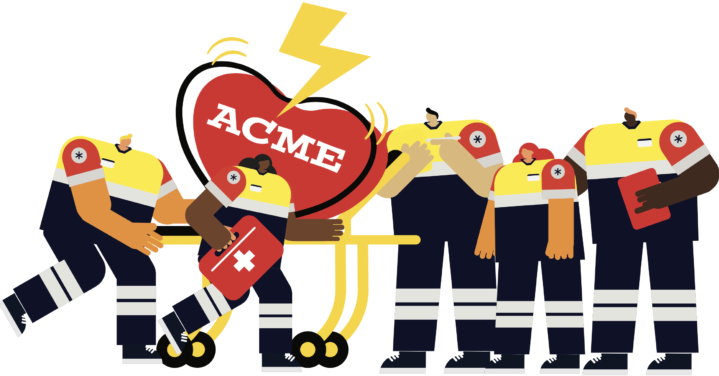Your business is dying – but it can be saved. Renewal demands a collective effort.
A few months ago, the Smiths Group chair and former 3M chief executive Sir George Buckley set us a challenge. “The core of every business is dying, yours included. You have to find a way to replace that dying core. What are you doing about it?” he asked us.
His question has been ringing in our ears ever since. But it’s not an easy one to answer. You can’t replace a dying core with a few extra percentage points of margin. Innovation is the only option.
Innovation requires perception, imagination, insight and judgment. But innovating fast enough to keep up with the pace and complexity of change, while replacing a decaying core, requires you to do all of these things all the time, in every corner of your business. It’s not something you can do by yourself. Even if you are the smartest person in the room, others will have ideas and see opportunities that you don’t.

Amazon Prime was a visionary idea, but it didn’t come from Jeff Bezos. The iPhone changed the world, but Steve Jobs initially hated it. Berkshire Hathaway made a fortune by investing in Apple, but the bet went against CEO Warren Buffett’s better judgment. In all cases, it wasn’t the genius boss but an employee who had a great idea, developed their reasoning, and convinced him to do something with it.
Nor is innovation something you can achieve simply by asking people to do it. If it were as easy as that, catchy slogans on the office wall and rousing town hall speeches would stimulate all the lightbulb moments you needed. Smart leaders have long recognized that if they want their organization to thrive, they need to empower their people to think for themselves. It sounds great in principle, but in practice, many leaders remain quietly skeptical. After all, it’s the leader who bears ultimate responsibility for the consequences. To empower people you might not have met without abdicating responsibility for their actions, you need to be sure that they’ll apply their brains to the right problems, and that they’ll do so transparently and with rigor.
So how do you do that? What we’ve seen in 15 years working with thousands of organizations, from Fortune 500s to non-governmental organizations, is that the most successful ones equip everyone with the skills, tools and confidence to produce breakthrough thinking that turns into decisive action. Rather than passively trust that things will work out, they actively build their ability to think as individuals and together. In other words, they create the conditions for collective intelligence. And this comes down to three things: critical thinking, great communication and a common focus on what matters.
How do you get everyone thinking?
In Gainesville, Florida, in 1965, Dewayne Douglas suspected something strange was happening to the college football team he coached, the Florida Gators. No matter how much water players drank, they almost never needed the bathroom during the half-time break. He knew they were sweating, but surely not that much.
Why weren’t they urinating more? Douglas couldn’t let this question go, so he asked a kidney specialist at the University of Florida, Dr Robert Cade. Cade conducted a series of experiments that revealed players were losing electrolytes as well as water. Their bodies were clinging onto every last drop of water to prevent the loss of more electrolytes. They had to sweat to keep cool, but trips to the bathroom could wait. All of this was affecting the players’ health – and their performance.
Cade’s methodical efforts to solve this problem, sparked by Douglas’s initial curiosity, resulted in the hugely successful sports drink Gatorade. It kick-started a multibillion-dollar industry.
Questions are the spark and the fuel of creativity, critical thinking and reasoning. But while we all start off as prodigious questioners, we ask fewer questions as we grow up. “There is what I call an answer orientation that permeates education, professional life and society at large,” explains Dr Lani Watson, a University of Oxford academic who researches questions and questioning. Because we value answers, we lose our ability to ask questions, which in turn reduces our capacity for creativity and critical thinking.
The good news is this is something we can all relearn. And the simple, obvious questions – like ‘Why?’, ‘So what?’ and ‘Now what?’ – are often the most powerful. It’s about making it normal to ask them – and keeping on asking them until you get a complete answer.
To do this, we have to make questioning an easy, yet unavoidable, part of people’s working lives. Fortunately, our daily routines are full of opportunities to do so – in the rituals that every business is run on, like stand-ups, one-to-ones and quarterly business reviews. You can embed the right questions into these activities by framing reports around them and getting people to answer them in pre-reads. You can also package questions up into set plays to cut to insight more quickly. Before long, asking the right questions becomes something that people do every day. And the discipline of asking questions becomes part of the organization’s culture.
What happens when good thinking meets bad communication?
Like grapes withering on a neglected vine, great ideas and insights can die if they’re not communicated well. To help convert great thinking into action, you need people to express themselves with clarity and impact.
Unfortunately, that’s rare even at the highest levels of business.
When we first met Sir Sandy Crombie, a veteran director whose firm had just brought us in to revamp their board deck, he pointed to his face and said, “This is not the face of a very old man. This is just the face of a man who has plowed through 5,500 pages in the last two days.” Having spoken to hundreds of others in his shoes and waded through the documents he was referring to, we could feel his pain.
It’s a problem that Winston Churchill, no less, tried to solve in 1940 when he penned a memo to British civil servants. “To do our work, we all have to read a mass of papers. Nearly all of them are far too long. This wastes time, while energy has to be spent in looking for the essential points… I ask my colleagues and their staffs to see to it that their reports are shorter.”
The fact that he sent similar messages a few months later, and then again in 1951, suggests it didn’t work. The problem is that most of us learn bad communication habits, disguised as best practice, from an early age.
In our work with boards and executive teams, we’ve identified four particular offenders.
1 Think the best way to make your case is with a snazzy slide deck? Wrong. Narrative reports are the best way to crystallize your thinking and get others to buy into it. Bezos went so far as to ban slides and bullet points at Amazon in favor of narrative memos, because he recognized that presentations prioritize style over substance. Writing forces people to think harder.
2 Think that good arguments first set the scene, then lay out the case and get to the conclusion at the end? That’s fine for essays; less so for time-poor colleagues. Put your bottom line up front or your reader may never reach it.
3 Think clever professionals use clever language? No. Short, simple words and sentences are more readable and impress more than long-winded jargon-fests.
4 Think data speaks for itself? If your data isn’t answering a question, it’s just more noise.
Getting people to unlearn these bad communication habits involves more than just telling them to do it, training or role-modeling, as Churchill showed. As with asking the right questions, the key is to make it difficult for them not to do it well. AI has a major role to play here. It cannot do an executive’s thinking for them, but it can act as a critical friend and skillful editor, providing the nudges and guide-rails that will help them do it better.
How do you make sure brainpower is focused on what matters?
“The main thing is to make sure that the main thing stays the main thing,” was a favorite saying of Jim Barksdale, Netscape’s chief executive, in the 1990s. Unfortunately, Netscape’s ‘main thing’ turned out to be the wrong thing. After a failed push into the enterprise market, the company lost ground to Microsoft and was discontinued in 2007.
Focus is essential for any business. Without it, you become a ship of busy fools rowing in different directions. But as Netscape’s experience shows, focus can easily turn into tunnel vision. You need to be able to switch to a new main thing when required.
This is easier said than done – and Netscape’s contemporary Nokia showed how tough it is. The Finnish mobile giant was famously blindsided by the smartphone, but its story is not one of myopia. “In ten years’ time I would like Nokia to be dubbed as the company that brought mobility and the internet together,” its chief executive Jorma Ollila told The Economist in 2000. Yet despite saying this repeatedly, he wasn’t able to turn the ship around fast enough.
Changing organizational focus begins with changing the questions that people ask. If you were asking ‘How can we cut costs?’ and now you want to ask ‘How can we delight our customers?’, put that question into all board papers, dashboards and management decks. Make it a priority for managers, who then make it a priority for their reports, and so on.
Sir Mick Davis, who we’ve worked with since his days running a Fortune 500 mining group, applied this approach to the acute challenge of growing an extractive business. “In our industry, the value of your asset goes down the minute you take something out of the ground,” he told us.
Davis introduced a question into the annual planning cycle which triggered a new way of thinking and a host of innovative ideas. “We asked each business how they planned to increase their net present value over the coming year. We wanted people to see value creation as an incremental set of improvements that you do every day. It could be anything – a smarter way of managing your fleet, or utilizing reagents in metallurgical processes. What mattered was that they knew they had to think about it.” Change the question, change the focus.
Bringing it together
Collective intelligence isn’t about hiring individually brilliant minds. It’s about creating the conditions for your entire organization to think well.
By baking questions into everyday work, you help people generate sharper insights and ideas. By building better rules into your internal communication, you help that thinking to travel. And by setting big picture questions that cascade through the business, you keep people’s thinking focused on the right things.
Empowering people to think for themselves like this takes some getting used to, particularly when you reached your position precisely because you were the smartest person in the room. But when change is constant, and consistent growth requires something extraordinary, the single smartest thing you can do as a leader is to build a business that is smarter than you are.
Jennifer Sundberg & Pippa Begg are co-CEOs of Board Intelligence and authors of Collective Intelligence: How to build a business that’s smarter than you (LID Publishing).



